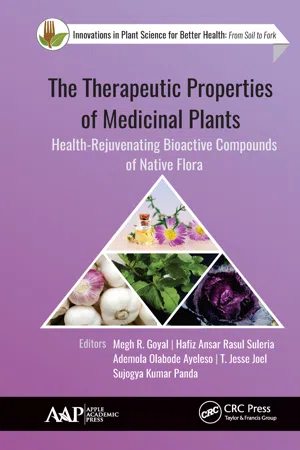Green vegetables are herbaceous plant species, whose parts are eaten as auxiliary food or core dishes. The consumption of green leafy vegetables is a major aspect of cultural heritage that plays vital functions in the customs, traditions, and food culture of traditional households. Nigeria is bestowed with a diversity of traditional vegetables; and different ethnic groups consume different vegetables for various beneficial reasons [58].
Vegetables are reaped at different phases of growth and consumed either in fresh, processed, or semi-processed state by humans, whereas they are generally given in the fresh form to livestock. The nutritional constituents of vegetables differ substantially, but generally, they are not main sources of carbohydrates in comparison with starchy foods. Nevertheless, vegetables are packed with ample quantities of crude fiber, vitamins, minerals, carotene, and essential amino acids [38, 79].
Green leafy vegetables are useful for the preservation of health and prevention of diseases, due to treasured food nutrients necessary for body build-up as well as repair [1, 35]. Aside from rich nutritional values of vegetables, they are the cheapest and most abundant source of proteins due to their ability to produce amino acids from simple materials like water, carbon dioxide as well as atmospheric nitrogen [13, 20]. Aside from their low methionine content, most species of green leafy vegetables have amino acid profiles comparable with those of egg, fish, meat, and soybean; and their amino acid profile exceeds the Food and Agriculture Organization (FAO) stipulated pattern of essential amino acids [13].
Vegetables have low calories as well as insignificant amounts of utilizable energy; and therefore, these are ideal for obese individuals who can gratify their appetite without fear of accumulating calories. Additionally, vegetables are valuable in conserving alkaline reserve of the human body by acting as buffering mediators for acidic substances in the GI tract [4].
This chapter presents an overview of the antioxidant potential of green leafy vegetables and their role in the prevention and/or mitigation of oxidative stress-related diseases.
1.2 Green Leafy Vegetables Versus Oxidative Stress-Related Diseases
Numerous human degenerative conditions (such as cancer, atherosclerosis, diabetes mellitus, heart disease, stroke, ulcers, rheumatoid arthritis, osteoporosis, cataract, sunburn, and aging) have been documented as the outcome of damage by free radicals and reactive oxygen species (ROS) [3]. Several studies have also been undertaken on how to prevent or avoid the onset of such diseases. Nevertheless, the most possible and practical approach for combating degenerative ailments is by increasing the body antioxidant status, which can be realized by more intake of fruits and vegetables. Green leafy vegetables typically contain high amounts of natural antioxidants, which are able to scavenge free radicals [24, 25, 84].
The antioxidant action of leafy vegetables may be due to the presence of biocompounds like flavones, isoflavone, flavonoids, catechin, isocatechin, and anthocyanin rather than only vitamins C, E, and β-carotene [65, 70]. Dietary antioxidants are essential to manage ROS, which cause damage to the DNA, RNA, alter proteins, and affect lipid peroxidation (LPO) in the cells. Antioxidants can inhibit the commencement or proliferation of oxidative stress in organisms [64]. Researchers have shown a keen interest in the study of antioxidants for combating the deleterious consequence of free radicals; and natural products such as fruits and vegetables are in the limelight of such studies. Green leafy vegetables with reported antioxidant properties are discussed in this section.
1.2.1 Talinum Triangulare (Water Leaf)
Talinum triangulare belongs to the family Portulacaceae, and originated from the tropical region of Africa, but it is extensively cultivated in Asia, South America and West Africa (especially in Nigeria) as a food crop [55]. It is greatly distributed in many ecological zones of Nigeria, where it is called ‘Gbure’ in Yoruba, ‘Nte-oka’ in Igbo and ‘Alenyruwa’ in Hausa [64]. T. triangulare is a perennial plant and is popularly called ‘waterleaf’ due to its high moisture content of approximately 90.8mg/100mg of edible leaf [86]. It is an herbaceous plant with succulent stem and pink flowers, which is used as a sauce, flavoring as well as condiment in foods. Furthermore, it is utilized in folk medicine to alleviate diuretic ailments, gastrointestinal disorder, and edema [9, 19, 58].
This plant is rich in protein, essential oils (EOs), total lipids, cardiac glyco-sides, flavonoids as well as polyphenols. Phytochemical studies have revealed the occurrence of omega-3-fatty acids and copious amounts of essential minerals such as calcium, potassium as well as magnesium. It also contains soluble fibers like pectin as well as vitamins C; α-tocopherol, β-tocopherols, and β-carotene that are required for growth and development [54, 68].
Anyasor et al., [19] investigated the in-vitro antioxidant activity of aqueous and methanol extracts of T. triangulare. They showed that both extracts tested positive to rapid thin layer chromatography (TLC) screening for the presence of antioxidant activity. The color change upon spraying with diphenyl picrylhydrazyl (DPPH) (deep violet to yellow spots) suggested the presence of free radical scavengers. Notably, the free radical scavenging ability of the extracts was increased with increase in the concentration of the extract. Additionally, thiobarbituric acid reactive (TBAR) substances assays indicated that the extract prevented LPO at a concentration of 100 µg/ml. A similar study by Amorim et al., [16] showed that the stems of this vegetable have phenolic compounds possessing high antioxidant activity based on the results of 1,1-diphenyl-2-picrylhydrazyl (DPPH) scavenging activity.
Liang et al., [55] evaluated the antioxidant activity of polysaccharides from T. triangulare. The polysaccharides were extracted with boiling water and deproteinized using the Savage method. The polysaccharides demonstrated varied degrees of antioxidant activities in a dose-dependent fashion, which necessitated further studies towards its utilization for the management of oxidative stress-induced diseases. Methanol and hydro-ethanol extracts of T. triangulare were also studied for their Fe3+ reducing ability and free radical scavenging activity. Results showed that both extracts demonstrated antioxidant activity, though the h...
